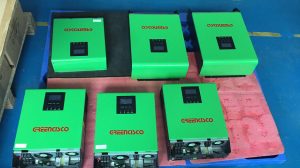
RFID Card Wholesale – How RFID Card Wholesale Benefits Omnichannel Retailers

RFID Card Wholesale – How RFID Card Wholesale Benefits Omnichannel Retailers
Radio-frequency identification, or RFID, is a technology that allows for the wireless transfer of data from a tag to a reader. It offers increased inventory accuracy and supply chain visibility for omnichannel retailers.
Retailers are finding new ways to use RFID for inventory management, supply chain visibility, and security, transforming brick-and-mortar stores and improving the customer experience. Here are four unique ways to incorporate RFID into your retail business strategy.
Access Control
RFID cards (Radio Frequency Identification) are a common type of access control card. These cards are designed to provide quick and convenient access for authorized users, while restricting entry to unauthorized people. They feature unique identifiers, multiple authentication levels, and sensitive personal information that allows companies to streamline processes while providing more security for their customers and employees.
The cards can be used to open doors or clock in employees at a particular location within a building. They also can be programmed with a variety of system features, including “clearance codes” which allow specific users to gain access on pre-defined days and times.
When someone tries to enter a door with an RFID card, the access control device detects the RFID tag and sends an electronic signal to unlock the electric strike at the door. This process takes about one second. Once the access card is unlocked, it sends a “valid access” transaction record to the access control server computer for storage.
For security, the system can also sound an audible alarm inside a building when a door is opened from the outside without a valid access card or by using equipment that isn’t properly installed with the system. This alert also allows the person responsible for the access control to monitor and respond to these alarms.
An access control system also records various types of system “transactions” on the access control server computer’s hard disk, called a system journal. These transactions are generally grouped into several categories, and the person managing the system can create reports of each category of activity.
Depending on the nature of the activity, these reports may be displayed on a computer screen or printed out on a printer. The flexibility of this report feature allows the person managing the access control to custom-tailor a report to meet their specific needs.
RFID access control systems can be a great way to give residents quick, easy access to their homes. However, they fail to offer the convenience of a modern access control solution that integrates smartphone-accessible IP intercoms and keypads. A cohesive environment using these modern systems can do more to enhance the resident experience than an RFID access control system ever could.
Event Management
Event organizers can save time and money by using RFID for event registration, ticketing, re-entry, and more. The technology speeds up ticket scanning and helps to prevent illegal entry by ensuring only ticket holders get in.
Organizers can also use RFID to create new opportunities for sponsors to engage attendees. For example, they can allow fans to enter raffles or competitions by simply showing their wristband or badge. This makes it easier for sponsors to track their attendance and measure the success of their investments.
Attendees can also pay for items with RFID-enabled payment terminals and kiosks. This helps reduce the number of tickets they carry around and allows fans to purchase their items from anywhere on the venue’s grounds.
RFID can also speed up ticket processing, especially for multi-day events. For example, SnowGlobe Music Festival recently switched to RFID and scanned in more than 20 people per minute at each gate.
The technology can be used for re-entry or VIP access, too. For example, if attendees are coming back for a second day, they can just wave their badge over the sensor to get in. This helps speed up access and eliminates the need for staff to operate scanners.
In addition, RFID tags are incredibly secure, which prevents the possibility of counterfeit tickets and other illegal access. These cards can be embedded with complex cryptography and are often Common Criteria certified, so they are difficult to reverse engineer or spoof.
One of the best features of RFID is that it can be integrated with other technologies, including mobile apps. rfid card wholesale This makes it easy for event staff to assign and manage RFID badges and wristbands on-site, which speeds up the event’s fulfillment process.
Using RFID to track the movement of customers and other visitors during an event can help organizers improve their layout or add lanes, booths, or concession stands. This can reduce traffic backups and bottlenecks in the event, and also make it easier for event staff to keep track of inventory.
In addition to these benefits, event organizers can use RFID to manage onsite sales and customer service. For example, if attendees want to upgrade their ticket to a VIP area, they can do so easily and seamlessly using their RFID-enabled wristband or badge. This lets VIPs enjoy a more elevated experience at the event and generates additional revenue for organizers.
Warehousing & Distribution
Whether you’re a B2B wholesaler or you sell a product that can’t fit into a physical retail space, warehousing and distribution are key parts of your supply chain. The right warehouse can help you maintain inventory in multiple locations and keep items fresh and ready to ship when orders come in.
The type of warehousing your business needs depends on what products you’re selling, how much stock you have and where the products will go. For example, if you’re selling perishable goods to a large number of customers in a country, it’s more important to have a system in place to ensure they’re safe, secure and ready for distribution when the need arises.
Warehousing is an essential part of the supply chain for many businesses, from large companies with a physical presence to small entrepreneurs who operate out of a garage. It involves receiving new stock, storing it, then tracking it. Some warehousing facilities offer climate control, which is necessary for certain types of products like frozen food or medicine.
You can also use a warehousing facility to store your stock until you’re ready to release it, giving you more flexibility and reducing delivery times. Some warehouses also provide return services to make it easier for customers to return items they don’t want.
Another reason to use a warehouse is if you’re a manufacturer and you need an extended amount of time to develop your product. For example, cheese makers and winemakers typically store their raw ingredients at a warehouse before they can start to make their final products.
A warehouse can also serve as a fulfillment center, which allows manufacturers to handle order processing, transportation management, and inventory and warehouse management in one place. This helps them keep track of the entire supply chain, as well as cut down on delivery costs and improve customer service.
As with any logistics business, warehousing requires management to ensure everything runs smoothly. This includes ensuring enough staff is trained and equipped for the job, equipment is maintained properly, safety and security are up to date, and relationships with shipping carriers are established. It also requires efficient and effective warehouse slotting to make sure products are accessed when they’re needed most.
Resorts & Theme Parks
Guests have come to expect RFID technology at resorts and theme parks. They are now using RFID wristbands, tickets and cashless payment options to streamline operations and enhance the guest experience.
As a result, the use of RFID has grown significantly in recent years, especially for waterparks and other theme parks. Specifically, waterproof silicone wristbands from RFIDSilicone have been used to great success in these venues, and this trend is expected to continue into the future.
RFID is a simple, effective and secure solution for guest access control, allowing guests to enter the park with a single swipe of their wristband. This reduces the need for staff at entry points and improves the overall experience for guests, while also lowering costs associated with additional labor.
When a guest loses their RFID wristband, they simply report it and a new one can be issued promptly. This ensures security and keeps payment information from being compromised in the event of theft.
Another benefit of RFID is that it allows guests to self-check in, reducing the need for staff at entrance gates. This saves time and can improve the first impression of your park, resulting in increased visitor retention and a higher average spend.
With the help of RFID, parks and attractions are able to collect intelligent data that can be used to streamline operations further. Whether it is determining traffic patterns, ride dwell times, or tapping into undiscovered rfid card wholesale operational efficiencies, these insights can have a significant impact on the guest experience.
Additionally, this data can be used to optimize merchandising, concessions and sales. These smart insights will provide the necessary information to improve guest satisfaction and encourage repeat visits.
In addition, RFID helps guests to stay safe by preventing them from contacting surfaces they shouldn’t. This can be useful for children visiting crowded attractions, particularly in the case of waterparks and amusement parks.
In order to maximize the benefits of RFID technology, resorts and theme parks should look to implement a system that will allow them to collect the most relevant data from their patrons. This can be accomplished by utilizing a variety of RFID solutions, including ticket verification and access control systems.

